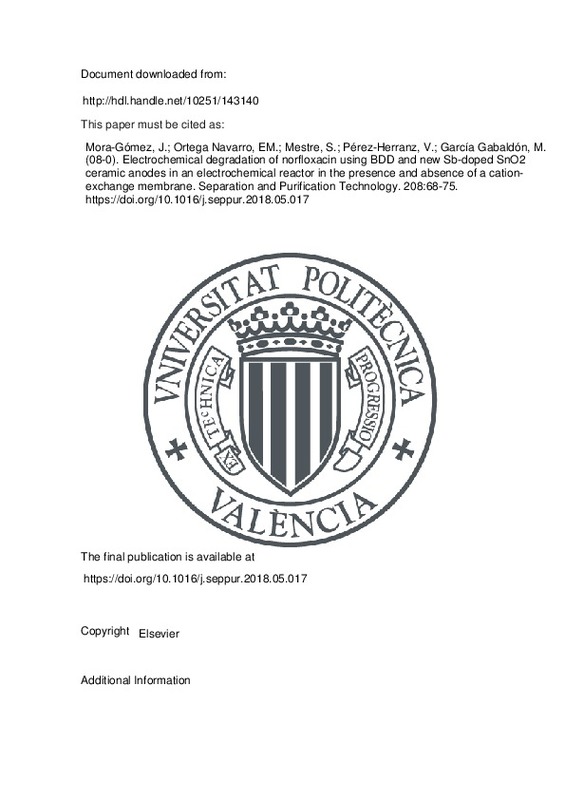JavaScript is disabled for your browser. Some features of this site may not work without it.
Buscar en RiuNet
Listar
Mi cuenta
Estadísticas
Ayuda RiuNet
Admin. UPV
Electrochemical degradation of norfloxacin using BDD and new Sb-doped SnO2 ceramic anodes in an electrochemical reactor in the presence and absence of a cation-exchange membrane
Mostrar el registro sencillo del ítem
Ficheros en el ítem
| dc.contributor.author | Mora-Gómez, Julia
|
es_ES |
| dc.contributor.author | Ortega Navarro, Emma María
|
es_ES |
| dc.contributor.author | Mestre, S.
|
es_ES |
| dc.contributor.author | Pérez-Herranz, Valentín
|
es_ES |
| dc.contributor.author | García Gabaldón, Montserrat
|
es_ES |
| dc.date.accessioned | 2020-05-14T03:05:03Z | |
| dc.date.available | 2020-05-14T03:05:03Z | |
| dc.date.issued | 2019-01-08 | es_ES |
| dc.identifier.issn | 1383-5866 | es_ES |
| dc.identifier.uri | http://hdl.handle.net/10251/143140 | |
| dc.description.abstract | [EN] Electrochemical oxidation of Norfloxacin (NOR) in sodium sulphate media has been comparatively studied in an undivided and in a divided electrolytic cell both containing either a boron doped diamond (BDD) or a novel Sb-doped SnO2 ceramic anode under galvanostatic operation. The electro-oxidation was found to occur with first order kinetics mainly when using both anodes. The results showed the great oxidizing power of BDD in relation to the ceramic anode to convert NOR and all the intermediate accumulated into CO2. In the case of the BDD, although a 92% of TOC abatement was achieved, the complete mineralization was not possible probably due to the carboxylic acids still present in solution. On the contrary, for the ceramic electrode, which presented a maximum value of TOC removal of about 63%, the total mineralization of the aromatic oxidation intermediates was not reached under the experimental conditions. The use of a membrane divided cell showed positive aspects in terms of molecule degradation, degree of mineralization and current efficiency since prevents the intermediate products formed during the NOR oxidation process from being reduced on the cathode. | es_ES |
| dc.language | Inglés | es_ES |
| dc.publisher | Elsevier | es_ES |
| dc.relation.ispartof | Separation and Purification Technology | es_ES |
| dc.rights | Reserva de todos los derechos | es_ES |
| dc.subject | BDD anode | es_ES |
| dc.subject | SnO2ceramic anode | es_ES |
| dc.subject | Electrochemical oxidation | es_ES |
| dc.subject | Norfloxacin | es_ES |
| dc.subject | Total organic carbon | es_ES |
| dc.subject.classification | INGENIERIA QUIMICA | es_ES |
| dc.title | Electrochemical degradation of norfloxacin using BDD and new Sb-doped SnO2 ceramic anodes in an electrochemical reactor in the presence and absence of a cation-exchange membrane | es_ES |
| dc.type | Artículo | es_ES |
| dc.identifier.doi | 10.1016/j.seppur.2018.05.017 | es_ES |
| dc.relation.projectID | info:eu-repo/grantAgreement/MINECO//CTQ2015-65202-C2-1-R/ES/CARACTERIZACION ELECTROQUIMICA DE ELECTRODOS CERAMICOS Y APLICACION A PROCESOS ELECTROQUIMICOS DE OXIDACION AVANZADA/ | es_ES |
| dc.rights.accessRights | Abierto | es_ES |
| dc.contributor.affiliation | Universitat Politècnica de València. Departamento de Ingeniería Química y Nuclear - Departament d'Enginyeria Química i Nuclear | es_ES |
| dc.description.bibliographicCitation | Mora-Gómez, J.; Ortega Navarro, EM.; Mestre, S.; Pérez-Herranz, V.; García Gabaldón, M. (2019). Electrochemical degradation of norfloxacin using BDD and new Sb-doped SnO2 ceramic anodes in an electrochemical reactor in the presence and absence of a cation-exchange membrane. Separation and Purification Technology. 208:68-75. https://doi.org/10.1016/j.seppur.2018.05.017 | es_ES |
| dc.description.accrualMethod | S | es_ES |
| dc.relation.publisherversion | https://doi.org/10.1016/j.seppur.2018.05.017 | es_ES |
| dc.description.upvformatpinicio | 68 | es_ES |
| dc.description.upvformatpfin | 75 | es_ES |
| dc.type.version | info:eu-repo/semantics/publishedVersion | es_ES |
| dc.description.volume | 208 | es_ES |
| dc.relation.pasarela | S\364220 | es_ES |
| dc.contributor.funder | Ministerio de Economía, Industria y Competitividad | es_ES |







![[Cerrado]](/themes/UPV/images/candado.png)

